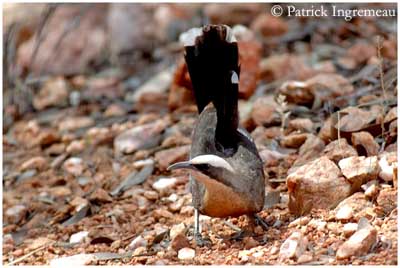
Grey-crowned Babbler
Pomatostomus temporalis
Passeriforme Order – Pomatostomidae Family
BIOMETRICS:
Length: 25 à 29 cm
Weight: 80 g
LONGEVITY: Up to 4 years
DESCRIPTION:
Grey-crowned Babbler is the largest of the four Australian Babblers.
Adult has greyish-brown upperparts. Long tail is darker, tipped with white. Wings are short and rounded with orange-buff wing patches.
Underparts are paler, with chestnut-brown lower breast, belly and vent. Chin and throat are white.
On the head, forehead, crown and nape are pale greyish-white, with indistinct grey band in the centre of crown. We can see dark grey band from lores, through the eye, and joining the mantel, giving a “masked” appearance.
Bill is thin, pointed and down curved. It is black, with pale base on lower mandible. Eyes are yellow. Legs and feet are grey.
Both sexes are similar.
Juvenile has dark eyes. They turn yellow when they are about three years old.
Grey-crowned Babbler has some predators such as Corvids.
Grey-crowned Babbler is in decline, and disappeared from large parts of its range. Next time, this species would become classified as Vulnerable.
Fr: Pomatostome à calotte grise
All : Grauscheitelsäbler
Ital : Garrulo corona grigia
Nd : Grijskruin-raltimalia
Photographs by Patrick Ingremeau
TAMANDUA
Text by Nicole Bouglouan
Sources:
Birds in backyards (Birds Australia and Australian Museum)
Wikipedia (Wikipedia, The Free Encyclopedia)

VOICE: SOUNDS BY XENO-CANTO
Grey-crowned Babbler utters loud scolding calls and chattering “wee-oo”. Breeding male and female perform duets. Female calls “yah” and male “ahoo”. These sounds may be repeated several times.
Grey-crowned Babbler is sometimes named “Yahoo”, due to these calls. They are used to maintain pair-bonds between mates, but also as territorial calls.
HABITAT:
Grey-crowned Babbler lives in wooded areas and open forests with mature eucalypts. It frequents inland plains with open shrub layer and intact ground cover of grass, fallen timber and leaf litter. It also can be found around farms, roadsides and sometimes golf courses.
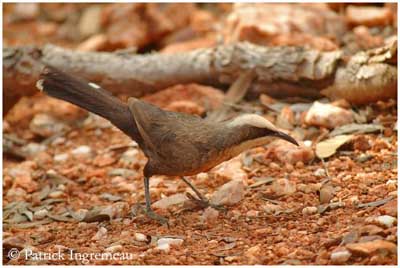
RANGE:
Grey-crowned Babbler is widespread in its range, in north-western, northern, central and eastern Australia. It also can be found in Papua New Guinea.
BEHAVIOUR:
Grey-crowned Babbler is very active and nervous. These birds live in family groups, up to 12 individuals. They defend communal territory. Each group includes one pair or a trio, with the young of previous year.
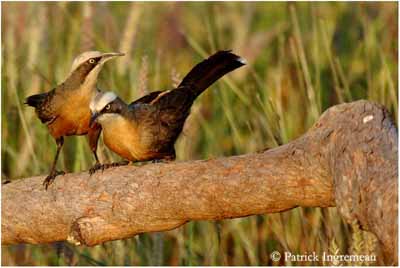
They feed together, on the ground among leaf litter, on branches where they forage from the bark, in fallen trees, performing short flights between each place. They also turn over stones, sticks and even cow-dung. They remain close to each other when foraging. Contact call is “chuck” between them.
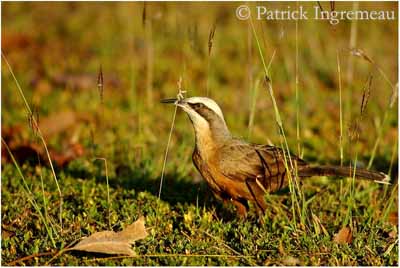
Grey-crowned Babbler is sedentary. Family groups defend the territory all year round. Territory ranges up to ten hectares.
Territorial fights can occur with groups of close territories. These disputes may last several hours and consist in calling, chasing and sometimes fighting.
FLIGHT:
Grey-crowned Babbler performs laborious flight and it is unable to fly over large open area. It prefers to hop in order to reach the treetop, and then it glides down to other tree.
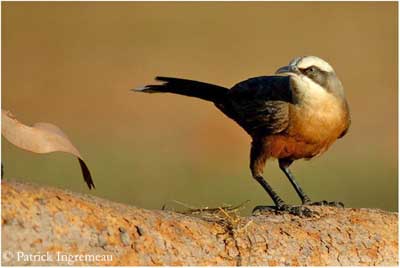
REPRODUCTION:
Grey-crowned Babbler nests in tree, shrubs and saplings. A group includes usually one dominant pair and several non-breeding birds. Each family group builds several nests which will be used as communal roosts at night. These large nests are situated at about six metres above the ground. They are dome-shaped, made with twigs, more or less thick and spherical, with lateral entrance. Old nest may be renovated and reused year after year.
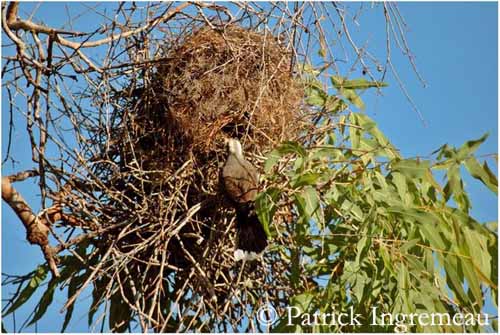
Another nest is built for breeding. Nest chamber is lined with soft materials such as grass, bark, wool and feathers. Breeding season occurs from July to February.
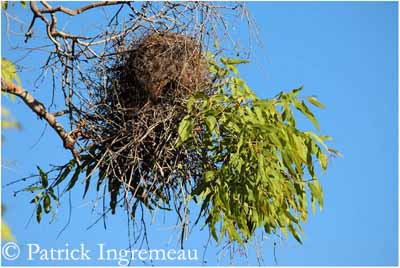
Female lays 2 to 3 brown eggs, with fine markings. Incubation lasts about 23 days, by female.
Several females may lay in the same nest, and all members of the group feed her, and then, help for feeding the young. Larger groups raise more young, and this species may produce two broods per year.
Young fledge at about 23 days after hatching. Young birds may stay about one year after fledging with family group, and sometimes, they remain for two or three more years. At this moment, even if they are able to breed, they act as helpers. That is very important for Grey-crowned Babbler long-term survival.
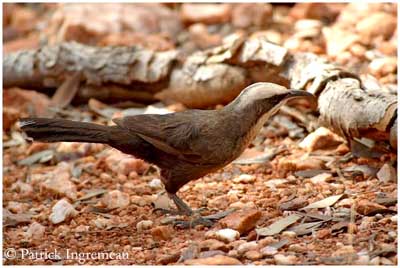
DIET:
Grey-crowned Babbler is insectivorous, foraging as on ground or in trees. It feeds mainly on insects and other invertebrates. It also may consume some seeds.
PROTECTION / THREATS / STATUS:
Grey-crowned Babbler is threatened by clearing and fragmentation of its habitat, and removal of dead timber. Its habitat is regularly cleared for agriculture. Weed invasion and grazing by stock degrades the habitat.
